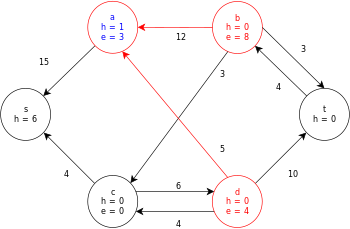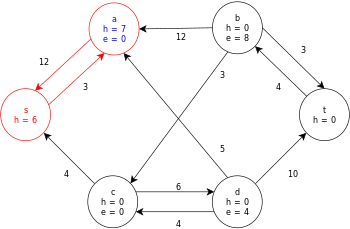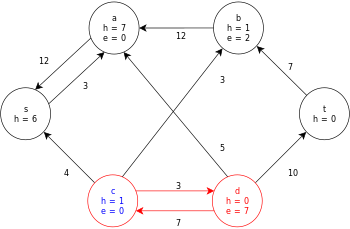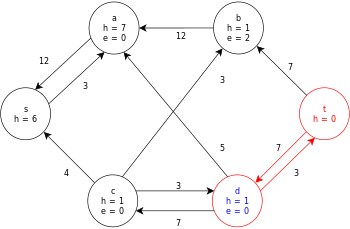Push-Relabel算法
2015-06-17 21:18
281 查看
Ford-Fulkerson方法还比较好理解
即每一次尝试都需要在剩余图里找到一条增强路径。让整个图的流量最大化。
这个算法主要的要点是这些:
1、尽可能多的(在边容纳范围内)向sink方向增大流。
2、source和sink的height都是定死的,一个是|V|另一个是0
3、height可以理解成该站的水位。如果比周围的站点都高,那他们就不能向此处增大流。
4、指针的意思是,A到B站可以还可以增大N个单位的流
5、流的唯一出口是sink节点。程序收敛时,每一个站要么已经没有库存流,要么无法向高位置的站发送流。(位高是由于边流量限制引发)
即每一次尝试都需要在剩余图里找到一条增强路径。让整个图的流量最大化。
这个算法主要的要点是这些:
1、尽可能多的(在边容纳范围内)向sink方向增大流。
2、source和sink的height都是定死的,一个是|V|另一个是0
3、height可以理解成该站的水位。如果比周围的站点都高,那他们就不能向此处增大流。
4、指针的意思是,A到B站可以还可以增大N个单位的流
5、流的唯一出口是sink节点。程序收敛时,每一个站要么已经没有库存流,要么无法向高位置的站发送流。(位高是由于边流量限制引发)
相关文章推荐
- Linux 常用的网络命令
- 安卓-屏幕适配方式
- DP中递归求方案
- Android使用页面布局操作SQLite数据库
- C++第12章项目,ATM机模拟队列。
- C++第13章 类继承
- 13 Roman to Integer(罗马数字转int Easy)
- 生成二维码(中间带logo) android
- Caused by: com.mysql.jdbc.exceptions.jdbc4.MySQLSyntaxErrorException: Unknown column 'XXX' in 'whe
- HDFS的运行原理
- Java 数组初始化
- Nginx缓存整理
- 关于今天晚上的一些总结
- Ubuntu默认防火墙安装、启用、配置、端口、查看状态相关信息
- hadoop常用命令
- opencv & qt study-(5)-操作图像中的像素
- qemu启动流程
- hadoop 2.5.2 + hive1.1.0 单机环境安装步骤
- Maven —— 管理SSH包
- Qt之QLineEdit之透明设置









